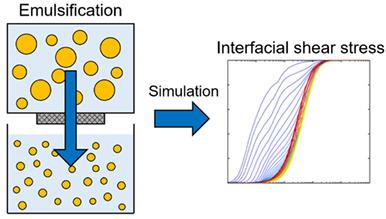当前位置:
X-MOL 学术
›
Can. J. Chem. Eng.
›
论文详情
Our official English website, www.x-mol.net, welcomes your feedback! (Note: you will need to create a separate account there.)
Investigation of local and temporal interfacial shear stress distribution during membrane emulsification
The Canadian Journal of Chemical Engineering ( IF 2.1 ) Pub Date : 2021-05-11 , DOI: 10.1002/cjce.24186 Tobias Wollborn 1 , Patrick Giefer 1 , Helena Kieserling 2 , Anja Maria Wagemans 2 , Stephan Drusch 3 , Udo Fritsching 1, 4
The Canadian Journal of Chemical Engineering ( IF 2.1 ) Pub Date : 2021-05-11 , DOI: 10.1002/cjce.24186 Tobias Wollborn 1 , Patrick Giefer 1 , Helena Kieserling 2 , Anja Maria Wagemans 2 , Stephan Drusch 3 , Udo Fritsching 1, 4
Affiliation

|
The production of high-quality liquid/liquid emulsions is a key factor in many industrial processes, such as in food or pharmaceutical industries. The premix emulsification process enables the controlled adjustment of fine and narrow distributed droplet sizes. Furthermore, premix emulsification in porous structures is considered a low-shear process that enables the usage and formulation of shear sensitive media (e.g., proteins). However, the local and time-dependent stress conditions and stress residence time at the droplet interface during droplet dispersion in micro-porous structures are still unknown. In this paper, interfacial stress distributions during droplet dispersion in premix membrane emulsification are numerically (computational fluid dynamics, CFD) investigated. Time-dependent stress conditions and stress residence times at the interface are calculated. The stress conditions are related to the droplet deformation process to identify the main mechanisms for droplet breakup. The results are compared to experimental analysis of the resulting droplet size distribution during emulsion formulation. It has been found that higher shear stresses occur at the pore wall, but lower shear stresses at the liquid/liquid (disperse/continuous) interface are responsible for the droplet dispersion process. The stress residence time shows that lower stresses are present over a longer time compared to higher stresses. This is relevant for the understanding of the dispersion process, but also for the use of shear sensitive media (e.g., proteins as emulsifier).
中文翻译:

膜乳化过程中局部和时间界面剪切应力分布的研究
高质量液体/液体乳液的生产是许多工业过程中的关键因素,例如食品或制药工业。预混乳化过程能够控制调节细小和窄分布的液滴尺寸。此外,多孔结构中的预混乳化被认为是一种低剪切过程,可以使用和配制剪切敏感介质(例如蛋白质)。然而,在微孔结构中液滴分散过程中,液滴界面处的局部和时间相关的应力条件和应力停留时间仍然未知。在本文中,对预混膜乳化液滴分散过程中的界面应力分布进行了数值研究(计算流体动力学,CFD)。计算了与时间相关的应力条件和界面处的应力停留时间。应力条件与液滴变形过程有关,以确定液滴破裂的主要机制。将结果与乳液配制过程中所得液滴尺寸分布的实验分析进行比较。已经发现较高的剪切应力发生在孔壁处,但液/液(分散/连续)界面处的较低剪切应力是液滴分散过程的原因。应力停留时间表明,与较高应力相比,较低应力存在的时间更长。这与理解分散过程有关,也与使用剪切敏感介质(例如,蛋白质作为乳化剂)有关。应力条件与液滴变形过程有关,以确定液滴破裂的主要机制。将结果与乳液配制过程中所得液滴尺寸分布的实验分析进行比较。已经发现较高的剪切应力发生在孔壁处,但液/液(分散/连续)界面处的较低剪切应力是液滴分散过程的原因。应力停留时间表明,与较高应力相比,较低应力存在的时间更长。这与理解分散过程有关,也与使用剪切敏感介质(例如,蛋白质作为乳化剂)有关。应力条件与液滴变形过程有关,以确定液滴破裂的主要机制。将结果与乳液配制过程中所得液滴尺寸分布的实验分析进行比较。已经发现较高的剪切应力发生在孔壁处,但液/液(分散/连续)界面处的较低剪切应力是液滴分散过程的原因。应力停留时间表明,与较高应力相比,较低应力存在的时间更长。这与理解分散过程有关,也与使用剪切敏感介质(例如,蛋白质作为乳化剂)有关。将结果与乳液配制过程中所得液滴尺寸分布的实验分析进行比较。已经发现较高的剪切应力发生在孔壁处,但液/液(分散/连续)界面处的较低剪切应力是液滴分散过程的原因。应力停留时间表明,与较高应力相比,较低应力存在的时间更长。这与理解分散过程有关,也与使用剪切敏感介质(例如,蛋白质作为乳化剂)有关。将结果与乳液配制过程中所得液滴尺寸分布的实验分析进行比较。已经发现较高的剪切应力发生在孔壁处,但液/液(分散/连续)界面处的较低剪切应力是液滴分散过程的原因。应力停留时间表明,与较高应力相比,较低应力存在的时间更长。这与理解分散过程有关,也与使用剪切敏感介质(例如,蛋白质作为乳化剂)有关。应力停留时间表明,与较高应力相比,较低应力存在的时间更长。这与理解分散过程有关,也与使用剪切敏感介质(例如,蛋白质作为乳化剂)有关。应力停留时间表明,与较高应力相比,较低应力存在的时间更长。这与理解分散过程有关,也与使用剪切敏感介质(例如,蛋白质作为乳化剂)有关。
更新日期:2021-05-11
中文翻译:

膜乳化过程中局部和时间界面剪切应力分布的研究
高质量液体/液体乳液的生产是许多工业过程中的关键因素,例如食品或制药工业。预混乳化过程能够控制调节细小和窄分布的液滴尺寸。此外,多孔结构中的预混乳化被认为是一种低剪切过程,可以使用和配制剪切敏感介质(例如蛋白质)。然而,在微孔结构中液滴分散过程中,液滴界面处的局部和时间相关的应力条件和应力停留时间仍然未知。在本文中,对预混膜乳化液滴分散过程中的界面应力分布进行了数值研究(计算流体动力学,CFD)。计算了与时间相关的应力条件和界面处的应力停留时间。应力条件与液滴变形过程有关,以确定液滴破裂的主要机制。将结果与乳液配制过程中所得液滴尺寸分布的实验分析进行比较。已经发现较高的剪切应力发生在孔壁处,但液/液(分散/连续)界面处的较低剪切应力是液滴分散过程的原因。应力停留时间表明,与较高应力相比,较低应力存在的时间更长。这与理解分散过程有关,也与使用剪切敏感介质(例如,蛋白质作为乳化剂)有关。应力条件与液滴变形过程有关,以确定液滴破裂的主要机制。将结果与乳液配制过程中所得液滴尺寸分布的实验分析进行比较。已经发现较高的剪切应力发生在孔壁处,但液/液(分散/连续)界面处的较低剪切应力是液滴分散过程的原因。应力停留时间表明,与较高应力相比,较低应力存在的时间更长。这与理解分散过程有关,也与使用剪切敏感介质(例如,蛋白质作为乳化剂)有关。应力条件与液滴变形过程有关,以确定液滴破裂的主要机制。将结果与乳液配制过程中所得液滴尺寸分布的实验分析进行比较。已经发现较高的剪切应力发生在孔壁处,但液/液(分散/连续)界面处的较低剪切应力是液滴分散过程的原因。应力停留时间表明,与较高应力相比,较低应力存在的时间更长。这与理解分散过程有关,也与使用剪切敏感介质(例如,蛋白质作为乳化剂)有关。将结果与乳液配制过程中所得液滴尺寸分布的实验分析进行比较。已经发现较高的剪切应力发生在孔壁处,但液/液(分散/连续)界面处的较低剪切应力是液滴分散过程的原因。应力停留时间表明,与较高应力相比,较低应力存在的时间更长。这与理解分散过程有关,也与使用剪切敏感介质(例如,蛋白质作为乳化剂)有关。将结果与乳液配制过程中所得液滴尺寸分布的实验分析进行比较。已经发现较高的剪切应力发生在孔壁处,但液/液(分散/连续)界面处的较低剪切应力是液滴分散过程的原因。应力停留时间表明,与较高应力相比,较低应力存在的时间更长。这与理解分散过程有关,也与使用剪切敏感介质(例如,蛋白质作为乳化剂)有关。应力停留时间表明,与较高应力相比,较低应力存在的时间更长。这与理解分散过程有关,也与使用剪切敏感介质(例如,蛋白质作为乳化剂)有关。应力停留时间表明,与较高应力相比,较低应力存在的时间更长。这与理解分散过程有关,也与使用剪切敏感介质(例如,蛋白质作为乳化剂)有关。



























 京公网安备 11010802027423号
京公网安备 11010802027423号